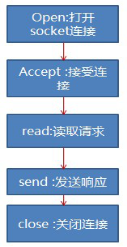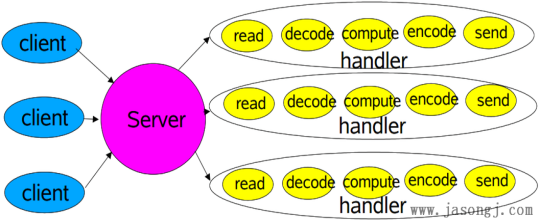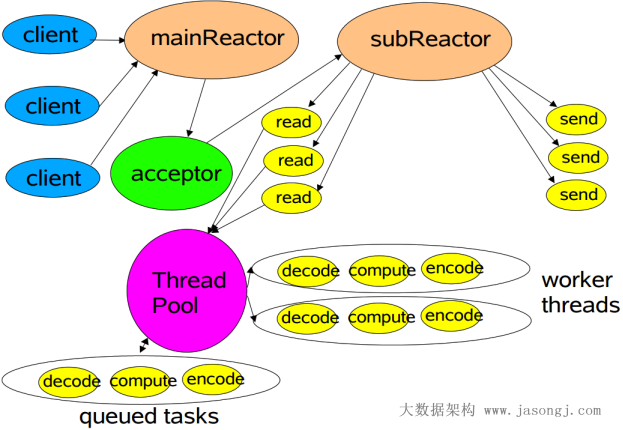Java NIO Reactor模式
一、NIO介绍:
NIO模型:

1、Channel为连接通道,相当于一个客户端与服务器的一个连接,Selector为通道管理器,将Channel注册到Selector上,Selector管理着这些Channel,当管理的某个通道有事件到达时,Selector将会通知应用程序去处理;Selector工作的线程和处理网络事件的应用是在不同的线程中;
2、NIO 有一个主要的类Selector,这个类似一个观察者,只要我们把需要探知的socketchannel告诉Selector,我们接着做别的事情,当有事件发生时,他会通知我们,传回一组SelectionKey,我们读取这些Key,就会获得我们刚刚注册过的socketchannel,然后,我们从这个Channel中读取数据,放心,包准能够读到,接着我们可以处理这些数据。
3、Selector内部原理实际是在做一个对所注册的channel的轮询访问,不断的轮询(目前就这一个算法),一旦轮询到一个channel有所注册的事情发生,比如数据来了,他就会站起来报告,交出一把钥匙,让我们通过这把钥匙来读取这个channel的内容。
其使用流程如下:

二、单线程BIO实现:
BIO也即Blocking IO,即阻塞的IO;
传统的BIO使用流程如下:

public class IOServer {
public static void main(String[] args) {
ServerSocket serverSocket = null;
try {
serverSocket = new ServerSocket();
serverSocket.bind(new InetSocketAddress(2345));
} catch (IOException ex) {
return;
}
try{
while(true) {
Socket socket = serverSocket.accept();
InputStream inputstream = socket.getInputStream();
IOUtils.closeQuietly(inputstream);
}
} catch(IOException ex) {
IOUtils.closeQuietly(serverSocket);
}
}
}
三、多线程BIO实现:
上例使用单线程逐个处理所有请求,同一时间只能处理一个请求,等待I/O的过程浪费大量CPU资源,同时无法充分使用多CPU的优势。下面是使用多线程对阻塞I/O模型的改进。一个连接建立成功后,创建一个单独的线程处理其I/O操作。

public class IOServerMultiThread {
public static void main(String[] args) {
ServerSocket serverSocket = null;
try {
serverSocket = new ServerSocket();
serverSocket.bind(new InetSocketAddress(2345));
} catch (IOException ex) {
return;
}
try{
while(true) {
Socket socket = serverSocket.accept();
new Thread( () -> {
try{
InputStream inputstream = socket.getInputStream();
IOUtils.closeQuietly(inputstream);
} catch (IOException ex) {
}
}).start();
}
} catch(IOException ex) {
IOUtils.closeQuietly(serverSocket);
}
}
}
四、线程池处理BIO实现:
从上面的代码可以看到:当accept返回(也就是有数据网络数据到达时),创建一个线程,并在线程中处理网络读写以及逻辑处理;
为了防止连接请求过多,导致服务器创建的线程数过多,造成过多线程上下文切换的开销。可以通过线程池来限制创建的线程数:
public class IOServerThreadPool {
public static void main(String[] args) {
ExecutorService executorService = Executors.newFixedThreadPool(Runtime.getRuntime().availableProcessors());
ServerSocket serverSocket = null;
try {
serverSocket = new ServerSocket();
serverSocket.bind(new InetSocketAddress(2345));
} catch (IOException ex) {
return;
}
try{
while(true) {
Socket socket = serverSocket.accept();
executorService.submit(() -> {
try{
InputStream inputstream = socket.getInputStream();
} catch (IOException ex) {
}
});
}
} catch(IOException ex) {
try {
serverSocket.close();
} catch (IOException e) {
}
}
}
}
与上面的代码的区别之处在读写网络数据的线程是从线程池里面分配的,充分利用了线程,避免了大量创建线程的开销以及线程上下文切换的开销;
五、经典Reactor模式实现:

上面的模型也即NIO的标准模型,可以看到:多个Channel可以注册到同一个Selector对象上,实现了一个线程同时监控多个请求状态(Channel)。同时注册时需要指定它所关注的事件;
Acceptor处理客户端的连接请求,handlers(read,decode, compute, encode, send)执行非阻塞的读写,Reactor将IO事件派发给相应handlers来处理;Acceptor和handlers使用的是同一个管理器Selector,并且是在同一个线程中处理的;
public class NIOServer {
public static void main(String[] args) throws IOException {
Selector selector = Selector.open();
ServerSocketChannel serverSocketChannel = ServerSocketChannel.open();
serverSocketChannel.configureBlocking(false);
serverSocketChannel.bind(new InetSocketAddress(1234));
serverSocketChannel.register(selector, SelectionKey.OP_ACCEPT);
while (selector.select() > 0) {
Set<SelectionKey> keys = selector.selectedKeys();
Iterator<SelectionKey> iterator = keys.iterator();
while (iterator.hasNext()) {
SelectionKey key = iterator.next();
iterator.remove();
if (key.isAcceptable()) {
ServerSocketChannel acceptServerSocketChannel = (ServerSocketChannel) key.channel();
SocketChannel socketChannel = acceptServerSocketChannel.accept();
socketChannel.configureBlocking(false);
socketChannel.register(selector, SelectionKey.OP_READ);
} else if (key.isReadable()) {
SocketChannel socketChannel = (SocketChannel) key.channel();
ByteBuffer buffer = ByteBuffer.allocate(1024);
int count = socketChannel.read(buffer);
if (count <= 0) {
socketChannel.close();
key.cancel();
continue;
}
}
keys.remove(key);
}
}
}
}
selector.select()是阻塞的,当有至少一个通道可用时该方法返回可用通道个数。同时该方法只捕获Channel注册时指定的所关注的事件。
六、多工作线程的Reactor模式实现:
经典Reactor模式中,尽管一个线程可同时监控多个请求(Channel),但是所有handler以及acceptor的处理都在同一个线程中处理,无法充分利用多CPU的优势,同时读/写操作也会阻塞对新连接请求的处理。因此可以引入多线程,并行处理多个读/写操作,其模型如下图所示:

实现代码如下:
public class NIOServer {
public static void main(String[] args) throws IOException {
Selector selector = Selector.open();
ServerSocketChannel serverSocketChannel = ServerSocketChannel.open();
serverSocketChannel.configureBlocking(false);
serverSocketChannel.bind(new InetSocketAddress(1234));
serverSocketChannel.register(selector, SelectionKey.OP_ACCEPT);
while (true) {
Set<SelectionKey> keys = selector.selectedKeys();
Iterator<SelectionKey> iterator = keys.iterator();
while(iterator.hasNext()) {
SelectionKey key = iterator.next();
iterator.remove();
if (key.isAcceptable()) {
ServerSocketChannel acceptServerSocketChannel = (ServerSocketChannel) key.channel();
SocketChannel socketChannel = acceptServerSocketChannel.accept();
socketChannel.configureBlocking(false);
SelectionKey readKey = socketChannel.register(selector, SelectionKey.OP_READ);
readKey.attach(new Processor());
} else if (key.isReadable()) {
Processor processor = (Processor) key.attachment();
processor.process(key);
}
}
}
}
}
public class Processor {
private static final ExecutorService service = Executors.newFixedThreadPool(16);
public void process(SelectionKey selectionKey) {
service.submit(() -> {
ByteBuffer buffer = ByteBuffer.allocate(1024);
SocketChannel socketChannel = (SocketChannel) selectionKey.channel();
int count = socketChannel.read(buffer);
if (count < 0) {
socketChannel.close();
selectionKey.cancel();
return null;
} else if(count == 0) {
return null;
}
return null;
});
}
}
可以看到他与经典Reactor模式的区别就是handler处理(网络读写以及encode,computer,decode处理)是在线程池中申请一个线程来专门处理的,因此acceptor连接请求处理和网络读写请求处理是在不同的线程中,网络读写不会影响acceptor连接的处理,可以提高服务器对于连接处理的效率和相应速度;
七、多Reactor实现:
Selector的实现原理是对其所管理的所有Channel进行轮询查询(在一个单独的线程中),而上面的多线程工作Reactor模式仍然是在一个Selector上进行轮询查询acceptor和网络读写,Selector在处理网络读写的同时是无法进行acceptor连接的处理的,因此在Selector压力较大时会有网络延迟;
多Reactor是在网络读写与acceptor实在不同的Selector上,也即acceptor是在主Reactor上,网络读写是在子Reactor上,一个主Reactor负责监控所有的连接请求,多个子Reactor负责监控并处理读/写请求,减轻了主Reactor的压力,降低了主Reactor压力太大而造成的延迟。
并且每个子Reactor分别属于一个独立的线程,每个成功连接后的Channel的所有操作由同一个线程处理。这样保证了同一请求的所有状态和上下文在同一个线程中,避免了不必要的上下文切换,同时也方便了监控请求响应状态。
Mina的线程模型正是采用了这种模型;
模型如下图所示:

子Reactor个数是当前机器可用核数的两倍。对于每个成功连接的SocketChannel,通过round robin的方式交给不同的子Reactor。
示意代码如下:
public class NIOServer {
public static void main(String[] args) throws IOException {
Selector selector = Selector.open();
ServerSocketChannel serverSocketChannel = ServerSocketChannel.open();
serverSocketChannel.configureBlocking(false);
serverSocketChannel.bind(new InetSocketAddress(1234));
serverSocketChannel.register(selector, SelectionKey.OP_ACCEPT);
int coreNum = Runtime.getRuntime().availableProcessors();
Processor[] processors = new Processor[coreNum];
for (int i = 0; i < processors.length; i++) {
processors[i] = new Processor();
}
int index = 0;
while (selector.select() > 0) {
Set<SelectionKey> keys = selector.selectedKeys();
for (SelectionKey key : keys) {
keys.remove(key);
if (key.isAcceptable()) {
ServerSocketChannel acceptServerSocketChannel = (ServerSocketChannel) key.channel();
SocketChannel socketChannel = acceptServerSocketChannel.accept();
socketChannel.configureBlocking(false);
Processor processor = processors[(int) ((index++) % coreNum)];
processor.addChannel(socketChannel);
processor.wakeup();
}
}
}
}
}
public class Processor {
private static final ExecutorService service =
Executors.newFixedThreadPool(2 * Runtime.getRuntime().availableProcessors());
private Selector selector;
public Processor() throws IOException {
this.selector = SelectorProvider.provider().openSelector();
start();
}
public void addChannel(SocketChannel socketChannel) throws ClosedChannelException {
socketChannel.register(this.selector, SelectionKey.OP_READ);
}
public void wakeup() {
this.selector.wakeup();
}
public void start() {
service.submit(() -> {
while (true) {
if (selector.select(500) <= 0) {
continue;
}
Set<SelectionKey> keys = selector.selectedKeys();
Iterator<SelectionKey> iterator = keys.iterator();
while (iterator.hasNext()) {
SelectionKey key = iterator.next();
iterator.remove();
if (key.isReadable()) {
ByteBuffer buffer = ByteBuffer.allocate(1024);
SocketChannel socketChannel = (SocketChannel) key.channel();
int count = socketChannel.read(buffer);
if (count < 0) {
socketChannel.close();
key.cancel();
continue;
} else if (count == 0) {
continue;
} else {
System.out("{}\t Read message {}", socketChannel, new String(buffer.array()));
}
}
}
}
});
}
}
Java NIO Reactor模式的更多相关文章
- JAVA NIO non-blocking模式实现高并发服务器(转)
原文链接:JAVA NIO non-blocking模式实现高并发服务器 Java自1.4以后,加入了新IO特性,NIO. 号称new IO. NIO带来了non-blocking特性. 这篇文章主要 ...
- JAVA NIO non-blocking模式实现高并发服务器
JAVA NIO non-blocking模式实现高并发服务器 分类: JAVA NIO2014-04-14 11:12 1912人阅读 评论(0) 收藏 举报 目录(?)[+] Java自1.4以后 ...
- JAVA BIO,NIO,Reactor模式总结
传统同步阻塞I/O(BIO) 在NIO之前编写服务器使用的是同步阻塞I/O(Blocking I/O).下面是一个典型的线程池客服端服务器示例代码,这段代码在连接数急剧上升的情况下,这个服务器代码就会 ...
- 高性能IO之Reactor模式(转载)
讲到高性能IO绕不开Reactor模式,它是大多数IO相关组件如Netty.Redis在使用的IO模式,为什么需要这种模式,它是如何设计来解决高性能并发的呢? 最最原始的网络编程思路就是服务器用一个w ...
- Java NIO学习与记录(五): 操作系统的I/O模型
操作系统的I/O模型 在开始介绍NIO Reactor模式之前,先来介绍下操作系统的五种I/O模型,了解了这些模型,对理解java nio会有不小的帮助. 先来看下一个服务端处理一次网络请求的流程图: ...
- Java进阶(五)Java I/O模型从BIO到NIO和Reactor模式
原创文章,同步发自作者个人博客,http://www.jasongj.com/java/nio_reactor/ Java I/O模型 同步 vs. 异步 同步I/O 每个请求必须逐个地被处理,一个请 ...
- java NIO的多路复用及reactor模式【转载】
关于java的NIO,以下博客总结的比较详细,适合初学者学习(http://ifeve.com/java-nio-all/) 下面的文字转载自:http://www.blogjava.net/hell ...
- Java进阶知识点5:服务端高并发的基石 - NIO与Reactor模式以及AIO与Proactor模式
一.背景 要提升服务器的并发处理能力,通常有两大方向的思路. 1.系统架构层面.比如负载均衡.多级缓存.单元化部署等等. 2.单节点优化层面.比如修复代码级别的性能Bug.JVM参数调优.IO优化等等 ...
- 同步异步阻塞非阻塞Reactor模式和Proactor模式 (目前JAVA的NIO就属于同步非阻塞IO)
在高性能的I/O设计中,有两个比较著名的模式Reactor和Proactor模式,其中Reactor模式用于同步I/O,而Proactor运用于异步I/O操作. 在比较这两个模式之前,我们首先的搞明白 ...
随机推荐
- mybatis mapper配置文件 CustomerMapper.xml
Dao @Repositorypublic interface CustomerDAO { public void create(CustomerModel cm); public voi ...
- SharePoint online Multilingual support - Settings
博客地址:http://blog.csdn.net/FoxDave This post will talk about how to enable sharepoint online site mul ...
- React 新 Context API 在前端状态管理的实践
本文转载至:今日头条技术博客 众所周知,React的单向数据流模式导致状态只能一级一级的由父组件传递到子组件,在大中型应用中较为繁琐不好管理,通常我们需要使用Redux来帮助我们进行管理,然而随着Re ...
- L296 EST 科技英语翻译-美学取向 (上)
tips:对语言进行恰如其分的润饰,讲究词法.句法及篇章的粘连,增加可读性. 1 Accuracy 精确性 科技文章用词要求准确,尽量避免含糊不清和一词多义 dead air静空气 2 Paralle ...
- Python 基础学习day1
1.计算机的组成 CPU:相当于人的大脑,预算中心. 内存:临时加载数据或者程序. 缺点:断电即消失. 硬盘:存放所有的数据,输入输出设备. 2.什么是操作系统. 调控所有硬件与软件的中间介质. 3. ...
- 1.横向滚动条,要设置两个div包裹. 2. 点击切换视频或者图片. overflow . overflow-x
1.横向滚动条. div.1 > div.2 > img img img 第一: 设置 div.1 一个固定的宽度 和高度 . 例如宽度 700px; 高度是 120px; 设置 o ...
- WebService的一种简单应用方式入门
1.什么是WebService? WebService即Web服务,简单来讲,他就是一种跨编程语言和跨操作平台的远程调用技术. 2.Web服务: Web服务是基于HTTP和XML的技术:HTTP是互联 ...
- django本身提供了runserver,为什么不能用来部署(runserver与uWSGI的区别)
runserver方法是调试django时经常用到的运行方式,它使用django自带的. WSGI Server 运行,主要在测试和开发使用,并且runserver 开启的方式也是单线程. uWSGI ...
- Dubbo/jupiterSPI 扩展引用
ProviderTenantService providerResourceService = ExtensionLoader.getExtension(ProviderTenantService.c ...
- placeholder兼容性问题
由于placeholder是H5新属性,IE9及以下都不支持 解决办法:给input添加一个背景图,背景图里面添加placeholder内容,当焦点落在输入框中,背景图隐藏,即可做出类似的效果 代码: ...
